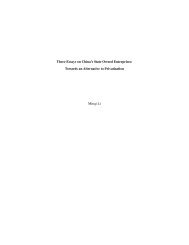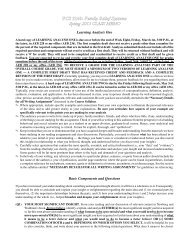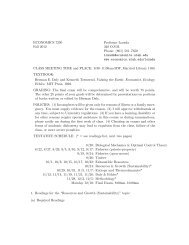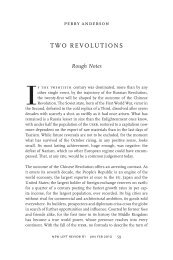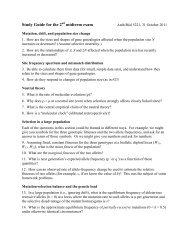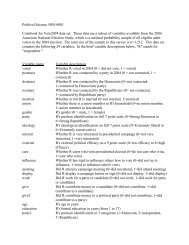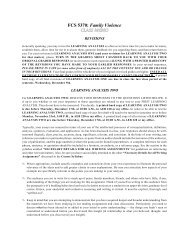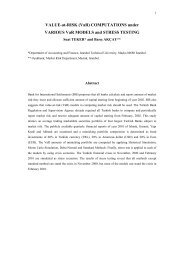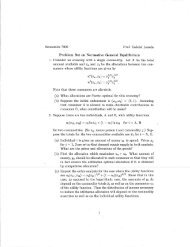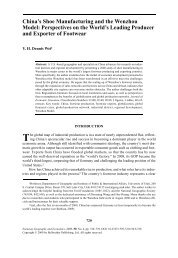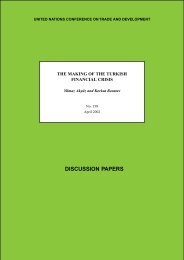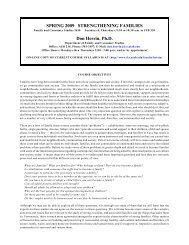Multiple choice questions (1 pt each)
Multiple choice questions (1 pt each)
Multiple choice questions (1 pt each)
You also want an ePaper? Increase the reach of your titles
YUMPU automatically turns print PDFs into web optimized ePapers that Google loves.
Ant1050 Midterm Exam Fall 2009 Name: 1<br />
Abbreviations involving time: ky, thousands of years;<br />
my, millions of years; kya, thousands of years ago; mya,<br />
millions of years ago.<br />
<strong>Multiple</strong> <strong>choice</strong> <strong>questions</strong> (1 <strong>pt</strong> <strong>each</strong>)<br />
1. Birds navigate by the stars. But how do they know<br />
which stars are in the north? Research shows that<br />
a. they have innate knowledge of which stars are in<br />
north<br />
b. they learn north by trial and error<br />
c. they learn north by watching stars rotate<br />
d. they learn north and south from their parents<br />
2. Most people do not desire sexual relations with siblings.<br />
How are such desires suppressed?<br />
a. We are not attracted to people with people with similar<br />
blood types.<br />
b. Children who are raised together learn not to be attracted<br />
to <strong>each</strong> other.<br />
c. The question is wrong: these desires are not suppressed.<br />
d. We are not attracted to people with facial features<br />
like those of our parents.<br />
3. Altruism is an ordinary English word, but it also has<br />
a technical meaning in evolutionary biology, and we<br />
have used it that way in this class. In this technical<br />
sense, we say that altruism has occurred when<br />
a. an action helpful to another individual is done without<br />
conscious intent.<br />
b. the action of one individual increases another’s fitness<br />
but reduces his own.<br />
c. an action enhances the reproductive success of altruist<br />
and recipient only if both cooperate.<br />
d. one individual helps another individual, whether or<br />
not this affects the fitness of the altruist.<br />
4. In Daly and Wilson’s study of 1972 Detroit crime<br />
statistics, which category of individual was least<br />
likely to to be killed?<br />
a. mother in law of killer<br />
b. stranger<br />
c. brother of killer<br />
d. wife of killer<br />
5. A gene predisposing its bearer towards altruistic acts<br />
would be favored by selection if the cost (to the altruist)<br />
were sufficiently small compared with the benefits<br />
(to the recipient), and if the to carry<br />
the gene.<br />
a. altruist were unlikely<br />
b. recipient were likely<br />
c. recipient were unlikely<br />
6. How does mating system affect sexual dimorphism<br />
among human societies?<br />
a. males are smaller than females, but only in polygynous<br />
societies only<br />
b. males are larger than females irrespective of the mating<br />
system<br />
c. males are smaller than females, but only in monogamous<br />
societies only<br />
d. males are larger than females, but only in monogamous<br />
societies only<br />
7. Chimpanzees have unusually large testes for their<br />
body size, probably because<br />
a. of widespread testicular infections<br />
b. the warm African climate makes spermatogenesis inefficient<br />
c. their body size has recently decreased<br />
d. their mating system causes lots of sperm competition<br />
8. What is unusual about the Wattled Jacana?<br />
a. Males are nearly 3 times as large as females.<br />
b. Males brood eggs and care for young; females don’t.<br />
c. Males and females look like different species.<br />
d. They are monogamous, yet highly sexually dimorphic.<br />
9. During the latter part of the Pleistocene (800kya to<br />
15kya) the earth’s temperature<br />
a. was about like the present<br />
b. swung back and forth between very cold periods and<br />
warm periods<br />
c. was stable but much colder than that of the present<br />
d. was stable but much warmer than that of the present
Ant1050 Midterm Exam Fall 2009 Name: 2<br />
10. The Greenland ice sheet provides a simultaneous<br />
record of temperature and atmospheric carbon dioxide<br />
(CO2) during the past 500ky. This record shows<br />
that when CO2 increases, the earth’s temperature<br />
a. decreases<br />
b. is unaffected<br />
c. also increases<br />
11. Between 5 and 1.5 my ago, the earth’s climate got<br />
a. colder<br />
b. warmer<br />
12. Early African Homo erectus (also called Homo ergaster)<br />
had<br />
a. a saggital crest, which indicates very powerful chewing<br />
muscles<br />
b. a larger eyes than earlier hominins<br />
c. curved fingers, which indicates that they spent time<br />
in trees<br />
d. a smaller gut and smaller teeth than earlier hominins<br />
13. The pronounced sagittal crest along the top of the<br />
skulls of robust australopithecines indicates that<br />
these species had<br />
a. massive jaw muscles.<br />
b. small brains.<br />
c. little hair on their scalps.<br />
d. massive neck muscles.<br />
14. The earliest spread of hominins out of Africa coincides<br />
with the appearance of<br />
a. H. habilis and the first tools<br />
b. A. robustus and an increase in molar size<br />
c. A. afarensis, bipedalism and stone tools<br />
d. H. erectus (or ergaster) and an increase in body size<br />
15. Brain tissue is energetically expensive. For this reason,<br />
Aiello and Wheeler (also Leonard, whom you<br />
read) argue that must have evolved together.<br />
a. large brains, rich diets, opposable thumb<br />
b. large brains, sagittal crests, vertical foreheads<br />
c. large brains, rich diets, small guts<br />
d. large brains, bipedal locomotion, large guts<br />
16. Hominin brains began to increase in size about<br />
a. 2,000,000 years ago<br />
b. 50,000 years ago<br />
c. 6,000,000 years ago<br />
d. 4,000,000 years ago<br />
17. Which of the following best describes the pattern<br />
of change in hominin brain size since the advent of<br />
genus Homo?<br />
a. Brains increased rapidly about 2,000,000 years ago<br />
and about 100,000 years ago, but were relatively constant<br />
in between.<br />
b. Brains have increased in size at a constant proportional<br />
rate.<br />
c. There is not enough data to decide between the other<br />
two answers.<br />
18. The earliest archaeological sites containing dense aggregations<br />
of stone tools and animal bone occur<br />
a. 2.6 kya<br />
b. 2.6 mya<br />
c. 260 kya<br />
d. 160 kya<br />
19. In some Plio-Pleistocene archaeological sites, we<br />
find overlapping tooth marks (made by carnivores)<br />
and cut marks (made by stone tools) on the same<br />
bone. What do these data tell us?<br />
a. Carnivores were attracted to the refuse of early hominin<br />
hunters.<br />
b. Early hominins were scavengers, not hunters.<br />
c. Early hominins were hunters, not scaventers.<br />
d. Sometimes humans ate before carnivores, and sometimes<br />
they ate after.<br />
20. Contemporary foragers rely heavily on<br />
meat than any other primate does.<br />
a. less<br />
b. more<br />
21. In “What are men good for,” Diamond argues that<br />
a. competition among sperm has adverse effect on females.<br />
b. selection favors males who hunt because such males<br />
get more extramarital sex.<br />
c. selection favors risk-taking in males because this<br />
helps them rise in status.<br />
d. men are larger than women because selection favors<br />
large males.
Ant1050 Midterm Exam Fall 2009 Name: 3<br />
22. When a population is driven almost to extinction but<br />
then recovers, it is said to have gone through a bottleneck.<br />
Such bottlenecks genetic variation<br />
within populations.<br />
a. decrease<br />
b. increase<br />
c. stabilize<br />
d. destabilize<br />
23. The Multiregional hypothesis holds that<br />
a. modern humans evolved within Africa and then expanded<br />
throughout the world, replacing earlier peoples<br />
as they went.<br />
b. modern humans evolved within Asia and then expanded<br />
throughout the world, hybridizing with resident<br />
archaic populations.<br />
c. after the dispersal of Homo erectus throughout Europe,<br />
Africa, and Asia, the various branches of the<br />
human population evolved in isolation from <strong>each</strong><br />
other, and different parts of this population r<strong>each</strong>ed<br />
the modern grade of development at slightly different<br />
times.<br />
d. modern humans evolved in a widespread population,<br />
which inhabited Europe, Africa, and Asia, and which<br />
was held together by substantial gene flow.<br />
24. The first hominin to inhabit all continents exce<strong>pt</strong><br />
Antarctica was<br />
a. Homo habilis<br />
b. Homo erectus<br />
c. Australopithecus africanus<br />
d. Homo sapiens
Ant1050 Midterm Exam Fall 2009 Name: 4<br />
Short-answer <strong>questions</strong> (3 <strong>pt</strong>s <strong>each</strong>)<br />
Be concise: 3 or 4 sentences per question. Do not repeat material that is given in the question.<br />
25. In a famous experiment, Garcia and Koelling offered water to thirsty rats. As they were drinking, the rats were exposed<br />
to one stimulus (flavor or noise). Shortly thereafter, they were exposed to another (illness or pain). The experiment<br />
thus had four treatments: (1) flavor/illness, (2) flavor/pain, (3) noise/illness, and (4) noise/pain. In which of these<br />
treatments did the rats learn to avoid the water? Summarize the conclusions that I drew from these results in lecture.<br />
26. Summarize the history of climate over the past 3 my.
Ant1050 Midterm Exam Fall 2009 Name: 5<br />
27. Some anthropologists have argued that big hominin brains evolved to help our ancestors find fruit. Each tree bears<br />
fruit only briefly. Once the fruit has been harvested, frugivores (fruit eating animals) must find another tree with fruit.<br />
I argued in lecture that this hypothesis is probably not true. Summarize the evidence.<br />
28. Homo erectus differed markedly from earlier australopithecines. List three ways in which they differed.
Ant1050 Midterm Exam Fall 2009 Name: 6<br />
29. Three million years ago, our ancestors had brains that were about the size of the brain of a modern chimpanzee. Today,<br />
our brains are three times as large. Summarize the history of this increase in brain size. When did hominid brain size<br />
increase? Which species of fossil hominid had brains that were larger than those of their predecessors?<br />
Don’t forget to write your name on the test.




